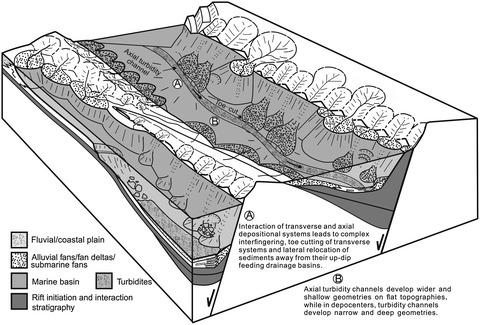当前位置:
X-MOL 学术
›
Basin Res.
›
论文详情
Our official English website, www.x-mol.net, welcomes your
feedback! (Note: you will need to create a separate account there.)
Sediment dispersal and redistributive processes in axial and transverse deep‐time source‐to‐sink systems of marine rift basins: Dampier Sub‐basin, Northwest Shelf, Australia
Basin Research ( IF 2.8 ) Pub Date : 2020-05-05 , DOI: 10.1111/bre.12462 Hehe Chen 1, 2, 3 , Lesli J. Wood 1 , Robert L. Gawthorpe 2
Basin Research ( IF 2.8 ) Pub Date : 2020-05-05 , DOI: 10.1111/bre.12462 Hehe Chen 1, 2, 3 , Lesli J. Wood 1 , Robert L. Gawthorpe 2
Affiliation

|
Morphological scaling relationships between source‐to‐sink segments have been widely explored in modern settings, however, deep‐time systems remain difficult to assess due to limited preservation of drainage basins and difficulty in quantifying complex processes that impact sediment dispersals. Integration of core, well‐logs and 3‐D seismic data across the Dampier Sub‐basin, Northwest Shelf of Australia, enables a complete deep‐time source‐to‐sink study from the footwall (Rankin Platform) catchment to the hanging wall (Kendrew Trough) depositional systems in a Jurassic late syn‐rift succession. Hydrological analysis identifies 24 drainage basins on the J50.0 (Tithonian) erosional surface, which are delimited into six drainage domains confined by NNE‐SSW trending grabens and their horsts, with drainage domain areas ranging between 29 and 156 km2. Drainage outlets of these drainage domains are well preserved along the Rankin Fault System scarp, with cross‐sectional areas ranging from 0.08 to 0.31 km2. Corresponding to the six drainage domains, sedimentological and geomorphological analysis identifies six transverse submarine fan complexes developing in the Kendrew Trough, ranging in areas from 43 to 193 km2. Seismic geomorphological analysis reveals over 90‐km‐long, slightly sinuous axial turbidity channels, developing in the lower topography of the Kendrew Trough which erodes toe parts of transverse submarine fan complexes. Positive scaling relationships exist between drainage outlet spacing and drainage basin length, and drainage outlet cross‐sectional area and drainage basin area, which indicates the geometry of drainage outlets can provide important constraints on source area dimensions in deep‐time source‐to‐sink studies. The broadly negative bias of fan area to drainage basin area ratios indicates net sediment losses in submarine fan complexes caused by axial turbidity current erosion. Source‐to‐sink sediment balance studies must be done with full evaluating of adjacent source‐to‐sink systems to delineate fans and their associated up‐dip drainages, to achieve an accurate tectonic and sedimentologic picture of deep‐time basins.
中文翻译:

海洋裂谷盆地轴向和横向深部源-汇系统中的沉积物扩散和再分布过程:澳大利亚西北大陆架Dampier盆地
在现代环境中已经广泛探讨了源汇段之间的形态比例关系,但是,由于流域的保存有限以及难以量化影响沉积物扩散的复杂过程,深层系统仍然难以评估。整合澳大利亚西北大陆架Dampier子盆地的岩心,测井和3D地震数据,可以完成从下盘(Rankin平台)集水区到上盘墙的完整的深层源-下沉研究(侏罗纪晚期同裂谷演替过程中的Kendrew Trough)沉积体系。水文分析确定了J50.0(Tithonian)侵蚀面上的24个流域,这些流域被划分为6个由NNE-SSW趋势岩钉及其成群作用限定的流域,流域范围在29至156 km之间2。这些排泄域的排泄口沿兰金断裂系统的陡坡保存得很好,其截面积范围为0.08至0.31 km 2。对应于六个排水域,沉积学和地貌学分析确定了肯德鲁海槽中发育的六个横向海底扇群,范围从43到193 km 2。地震地貌分析显示,在肯德鲁海槽的下部地形中形成了超过90公里长的略为弯曲的轴向浊度通道,该通道侵蚀了海底横向扇形复合体的趾部。排水口间距与流域长度,排水口横截面积和流域面积之间存在正比例关系,这表明排水口的几何形状可以在深层源头汇研究中对源头面积尺寸提供重要约束。 。扇形面积与流域面积之比的大致负偏差表明,由轴向浑浊电流侵蚀引起的海底扇形复合物中的净沉积物损失。
更新日期:2020-05-05
中文翻译:

海洋裂谷盆地轴向和横向深部源-汇系统中的沉积物扩散和再分布过程:澳大利亚西北大陆架Dampier盆地
在现代环境中已经广泛探讨了源汇段之间的形态比例关系,但是,由于流域的保存有限以及难以量化影响沉积物扩散的复杂过程,深层系统仍然难以评估。整合澳大利亚西北大陆架Dampier子盆地的岩心,测井和3D地震数据,可以完成从下盘(Rankin平台)集水区到上盘墙的完整的深层源-下沉研究(侏罗纪晚期同裂谷演替过程中的Kendrew Trough)沉积体系。水文分析确定了J50.0(Tithonian)侵蚀面上的24个流域,这些流域被划分为6个由NNE-SSW趋势岩钉及其成群作用限定的流域,流域范围在29至156 km之间2。这些排泄域的排泄口沿兰金断裂系统的陡坡保存得很好,其截面积范围为0.08至0.31 km 2。对应于六个排水域,沉积学和地貌学分析确定了肯德鲁海槽中发育的六个横向海底扇群,范围从43到193 km 2。地震地貌分析显示,在肯德鲁海槽的下部地形中形成了超过90公里长的略为弯曲的轴向浊度通道,该通道侵蚀了海底横向扇形复合体的趾部。排水口间距与流域长度,排水口横截面积和流域面积之间存在正比例关系,这表明排水口的几何形状可以在深层源头汇研究中对源头面积尺寸提供重要约束。 。扇形面积与流域面积之比的大致负偏差表明,由轴向浑浊电流侵蚀引起的海底扇形复合物中的净沉积物损失。











































 京公网安备 11010802027423号
京公网安备 11010802027423号